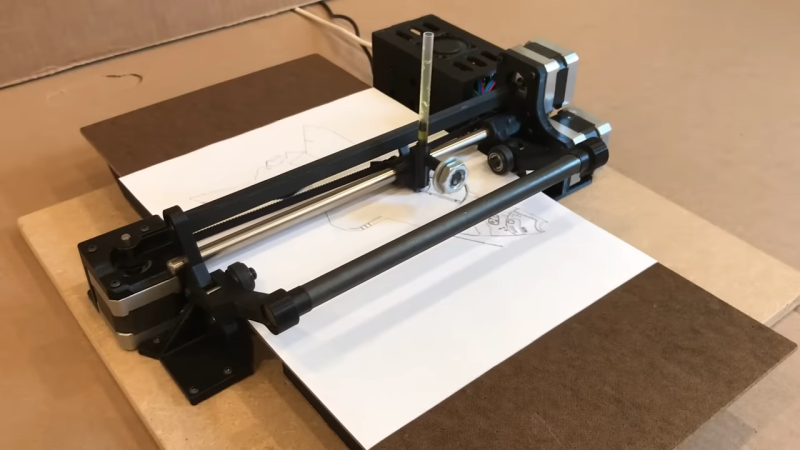We see a lot of simple pen plotter projects around here, and while we appreciate them one and all, most of them are a little on the slow side. That’s OK — a glacial pace is sometimes all that’s needed, as long as it gets the job done. But there’s nothing wrong with putting the pedal to the metal, so to speak. And that’s exactly what this super-fast Arduino-based plotter is all about.
As the story goes, [IV Projects] felt the need for speed after building an earlier pen plotter project that worked, but failed to excite. With the additional goal of keeping the plotter easy to build with cheap parts, the design centers on a “grit roller drive” for the Y-axis — the one that actually moves the paper back and forth. And move it does, using Dremel tool sanding drums on a lightweight shaft to maximize acceleration. In fact, all the moving parts are kept as lightweight as possible, and the results really show — the three steppers really sing when this plotter is in action.
There are some really clever details in [IV Projects]’ design. We particularly like the way the pen lift mechanism works, and the surprise appearance of a clothespin spring as a belt tensioner was a real treat. Judging by the pile of rejected prototype parts, it took quite a bit of work to get this design right. If you’d like to build your own, STLs are available for the printed parts.
If you’re interested in what the other end of the speed scale looks like, check out this bare-minimum pen plotter.















The clothespin spring belt tensioner is there because the working side of the belt is not parallel to the guide rails. That leads to varying tension and distorted drawings. The fix is to reposition the pulleys or the attachment to the pen carrier so the belt stays parallel to the guide rails. Then you wont need the spring tensioner.
If you really want to make it fly, try iHSV servomotors. I use them in my sand table with speeds up to about 2000 mm/sec and acceleration up to 2g. The problem you’ll have then is finding a pen that can deliver the ink fast enough. I experimented with plotting when I was building my 3D printer and found Koh-i-noor Rapidograph pens flow very well.
Amazing piece of work. Watching a pen plotter is always amazing – laser printers and the like hide the magic of putting ink on paper.
The selection of sample images is also quite neat. I’ve seen the Space Shuttle images before, but the other ones are quite cool
Super fast like an old HP (HP 7475A) that uses the same motion mechanism. The HP uses a very cool and inexpensive servo system and has optimized acceleration and deceleration of everything, including the pen-drop which touches the paper at zero velocity so the HP’s fine felt tips don’t get squashed.
There are papers in the HP Journal that describe the algorithms and also the optimal pinch roller setup. And there is an explanation for running the paper back and forth before printing starts to lay down the micro-impressions that will keep the paper aligned. I have a copy somewhere but I suppose they are all online now.
How are the steppers being driven? The step noise is pretty low.
I had one of the HP’s for the longest time to print schematics.
My pens always dry out.
This is a wonderful machine for the job it’s built to do: draw fast. That said, I don’t like that “grit roller” system deforms the edge of the paper. I much prefer the rubber roller system that computer printers use to move paper without leaving a (human) detectable impression.
Rubber roller caused some drift, paper was not repositioned correctly.
The printers I have taken apart (for the 8mm and 10mm nice ground rods) usually have steel rod with textured sections where the rubber rollers will press. They both spin. It feels like 250 to 350 grit.
That plotter is just screaming to draw itself ;)
Did you not watch the video?
I did. Did you?
This is awesome. Just screamed out tractor feed
See 5:14 in the video.
Reordering the drawing instruction to minimize the distance traveled with raised pen will probably shave of a few more seconds, but doing it perfectly is probably NP hard.
inkscape axidraw plugin has a feature similiar to that. Never investigated in detail but it probably does something simple like ordering the beggining of each path from left to right which is not as good as you’re suggesting but can make things a lot faster when you have lots of small paths.
Searching for G-code and optimization or HPGL and optimization yields dozens of tools and even some scientific papers.
Even the most naïve optimization based on immediate proximity would shave off possibly tens of seconds.
Perhaps use a ball point pen and feed compressed air into the ink reservoir to increase the flow rate.
How fast can you spin the ball before the ink will start to boil from shear forces.
I almost never have use for a plotter, but it’s comforting to know that based on this I could probably whip one up in a day :-)
They need to show a picture of the plotter without a piece of paper in it.